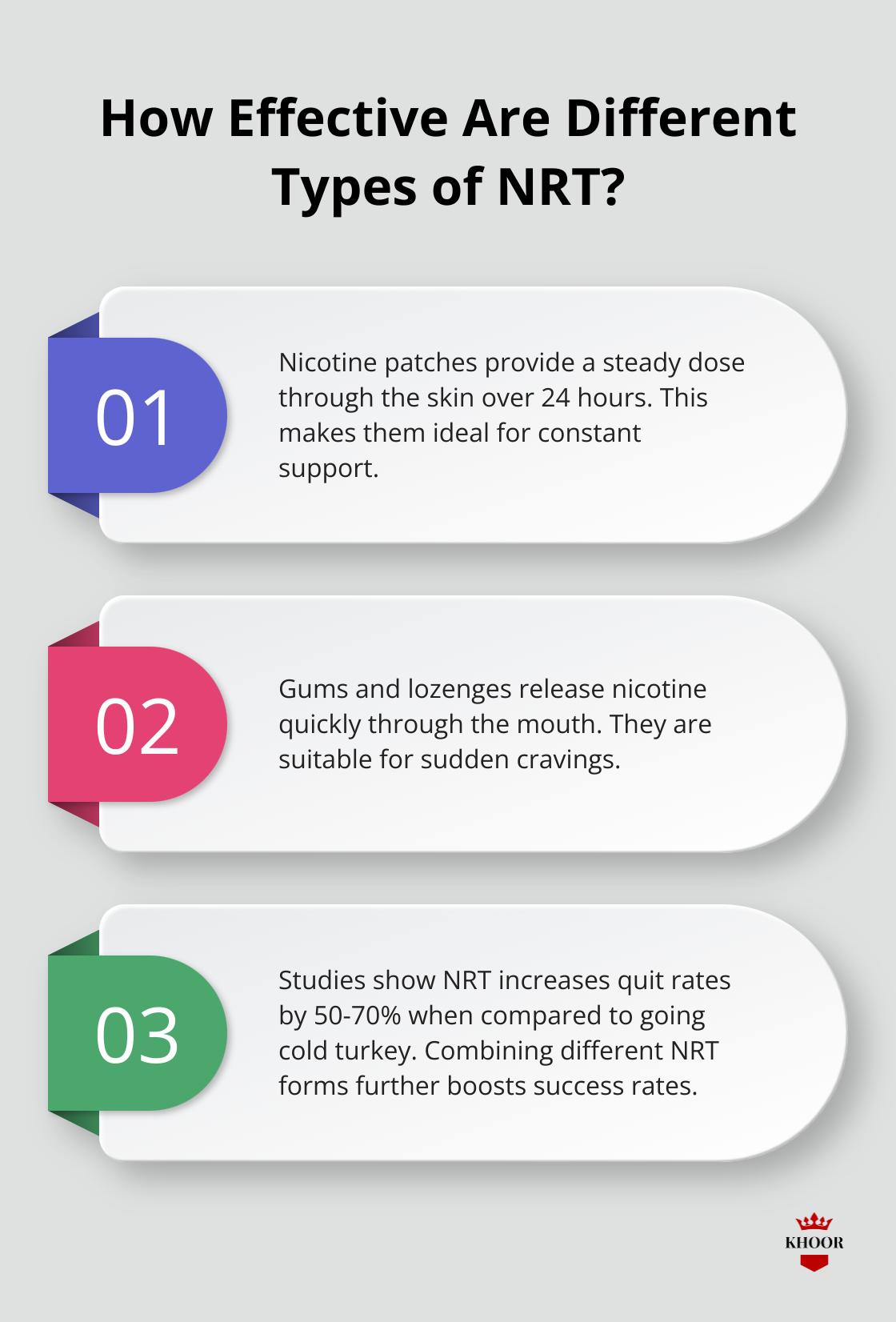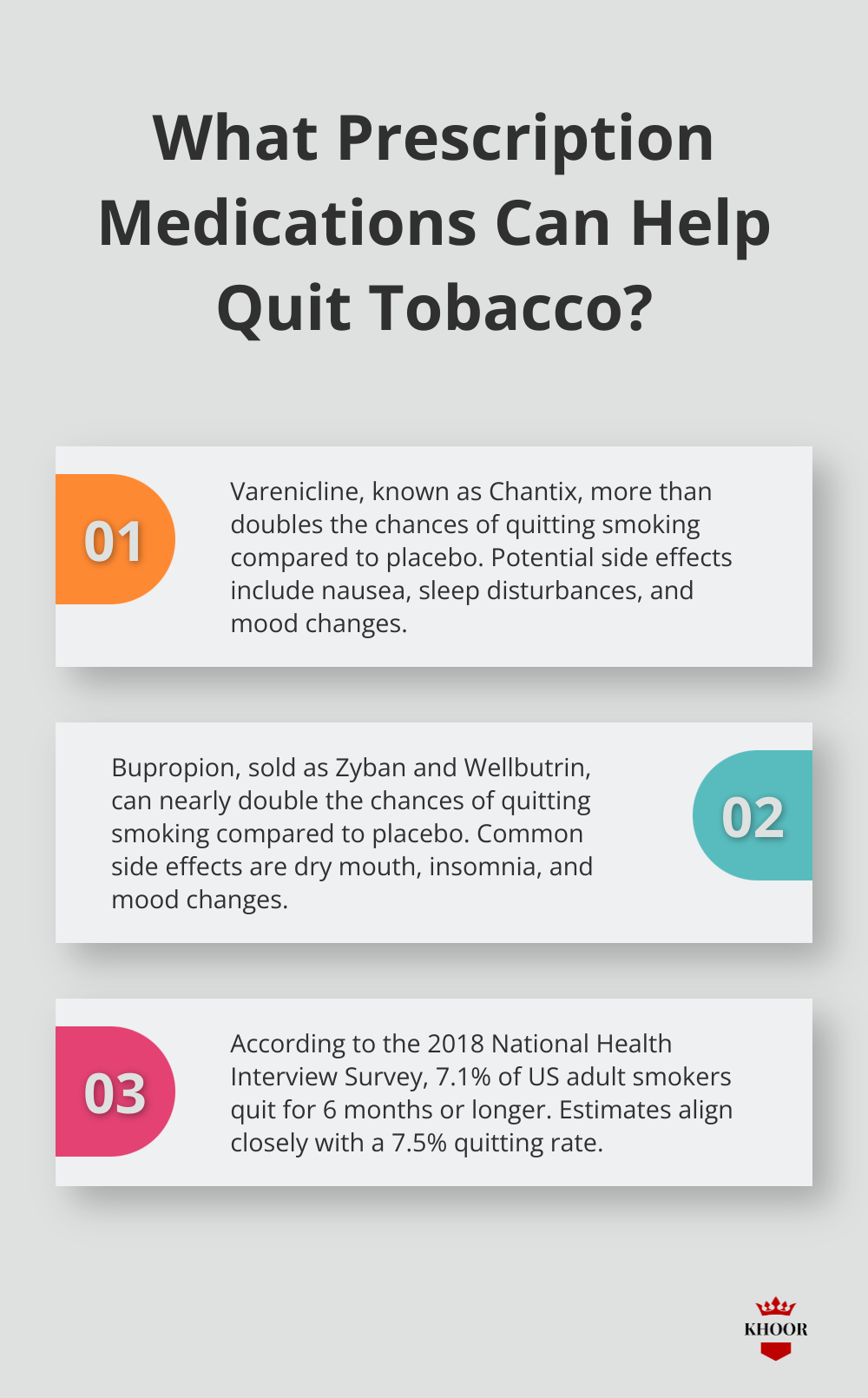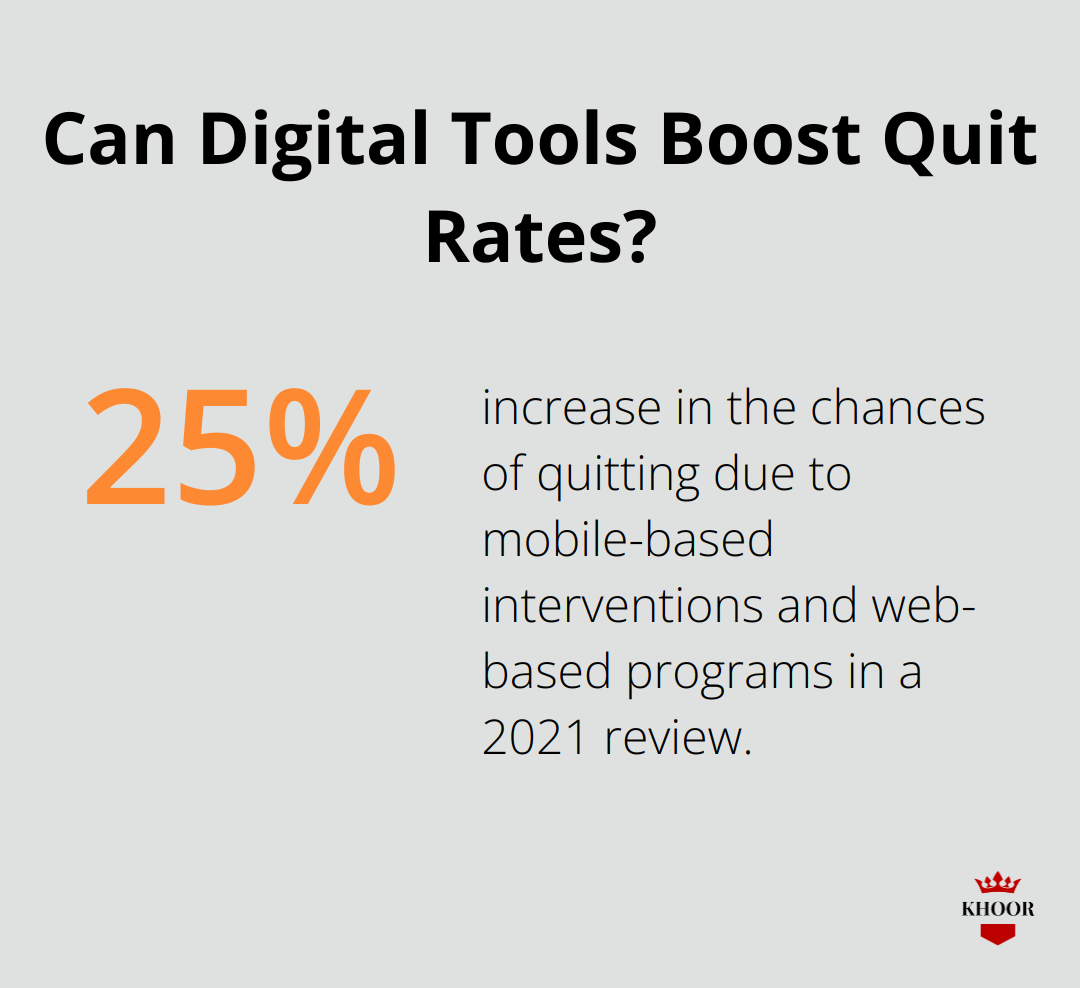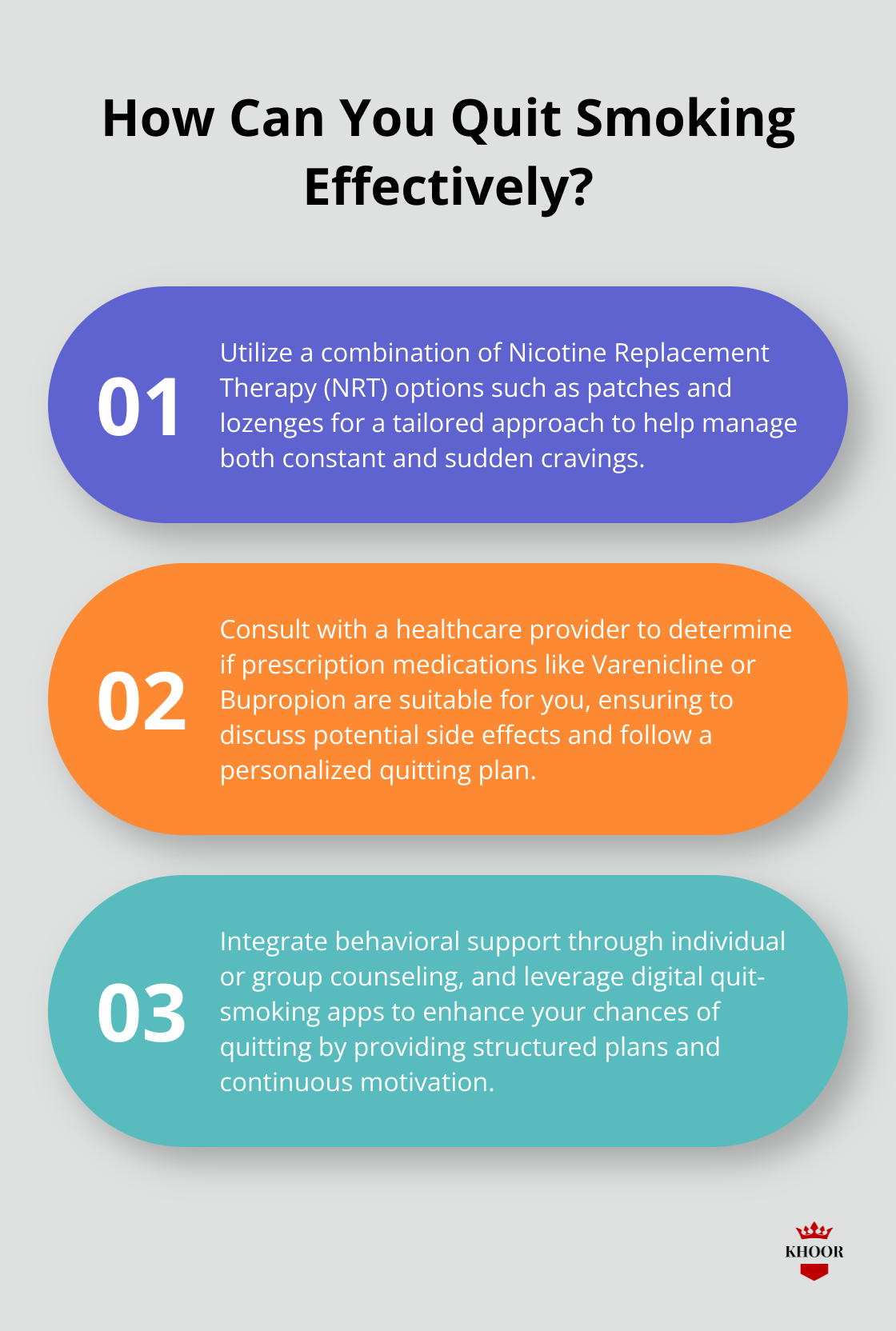
Herbal Smoking Wellness: All You Need to Know
Explore the benefits and tips of herbal smoking wellness with information on health impacts, botanical choices, and DIY blends.

Quitting tobacco can feel overwhelming, but it’s important to know that the best solutions for quitting tobacco is accessible.
At KHOOR, we understand the challenges and are here to provide practical, evidence-based guidance.
In this blog post, we’ll explore various methods to help you succeed on your journey towards a tobacco-free life.
Nicotine Replacement Therapy (NRT) is one of the most effective ways to quit tobacco. NRT works by supplying your body with a small, measured dose of nicotine—minus the other harmful chemicals in tobacco. This can ease withdrawal symptoms and help control cravings.
NRT comes in various forms, including patches, gums, lozenges, and sprays. Each type has its own benefits and best-use scenarios. Nicotine patches provide a steady dose of nicotine through the skin over a 24-hour period, making them ideal for people who require constant support. Gums and lozenges, on the other hand, release nicotine orally and quickly, making them suitable for sudden cravings. Nicotine sprays offer a rapid nicotine delivery as well but in a more discreet manner.
The effectiveness of NRT is well-documented. Studies show that using NRT can increase the chances of quitting by 50-70% compared to going cold turkey. In 2020, the Surgeon General’s report highlighted that combining multiple forms of NRT, such as using patches along with gum or lozenges, further boosts success rates. For example, a study published in the Cochrane Database of Systematic Reviews found that combination NRT is more effective than single-method therapy, with quit rates significantly higher at the six-month mark.
Selecting the right NRT product depends on your smoking habits and personal preferences. If you’re a heavy smoker, patches might be the best start due to their consistent nicotine delivery. For lighter smokers or those who need rapid relief, gums and lozenges might be more appropriate. A healthcare provider can offer personalized recommendations based on your specific needs. It’s also beneficial to initiate NRT before your quit date. Studies indicate that starting NRT a few weeks before quitting can enhance your readiness and improve outcomes. Combining different NRT products can provide more targeted support, addressing both constant and sudden cravings. For additional support, consider exploring the potential benefits of herbal cigarettes as an alternative to traditional options.

Prescription medications can be a powerful ally in quitting tobacco, especially when combined with other methods like NRT. Two of the most effective prescription medications for smoking cessation are Varenicline and Bupropion.
Varenicline, commonly known by its brand name Chantix, works by targeting nicotine receptors in the brain, reducing the pleasurable effects of smoking and easing withdrawal symptoms. Clinical trials have shown that Varenicline can more than double the chances of quitting smoking compared to placebo.

However, it’s important to be aware of potential side effects. Some users report nausea, sleep disturbances, and vivid dreams. In rare cases, Varenicline has been linked to mood changes and depression. Discussing these side effects with a healthcare provider is vital for managing them effectively and deciding whether Varenicline is the right choice for you.
Bupropion, also known by its brand names Zyban and Wellbutrin, is another prescription option that can aid in tobacco cessation. Originally an antidepressant, Bupropion helps reduce nicotine cravings and withdrawal symptoms by affecting neurotransmitters related to mood and reward. Studies indicate that Bupropion can nearly double the chances of quitting smoking compared to placebo.
Common side effects include dry mouth, insomnia, and potential changes in mood. It’s crucial to discuss these with a healthcare provider to determine the appropriateness of Bupropion for your quitting plan.
Consulting a healthcare provider is essential when considering prescription medications for quitting tobacco. According to the 2018 National Health Interview Survey, 7.1% of US adult smokers reported quitting smoking for 6 months or longer. This finding aligns with an estimate of 7.5%.
A healthcare provider can assess your medical history, smoking habits, and any potential contraindications to decide on the best medication for you. They can also provide a tailored quitting plan that includes behavioral support, which has been shown to increase the chances of success.
Regular follow-ups with your provider can help adjust dosages, manage side effects, and provide ongoing encouragement. Combining professional guidance with herbal cigarettes and prescription medications increases the likelihood of achieving a tobacco-free life.
Next, we’ll explore additional support methods and behavioral strategies to complement these medical interventions.
Behavioral support and counseling play a critical role in smoking cessation. Evidence shows that those who receive professional support are significantly more likely to succeed in quitting.
Individual counseling provides personalized strategies to tackle your smoking habits. Sessions often involve a thorough assessment of your smoking triggers and tailored solutions to address them. According to the CDC, brief advice from a physician can improve cessation rates. For instance, in 2015, almost 57.2% of adult smokers who saw a health professional received advice to quit.

Group counseling offers a supportive environment where you can share experiences and receive encouragement from others. This communal aspect can be a strong motivator, as you’ll see real examples of success and face the same challenges together.
Online programs and apps bring accessible support to your fingertips. Digital tools, such as quit-smoking apps, provide structured plans, progress tracking, and motivational messages. The convenience of digital support cannot be overstated; a 2021 review in the journal Tobacco Control highlighted that mobile-based interventions and web-based programs can increase the chances of quitting by around 25%.
Integrating behavioral support with NRT or prescription medications can amplify your chances of quitting. The Mayo Clinic recommends a combination of these methods for a holistic approach. Behavioral therapy helps address the psychological aspect of addiction, while NRT and medications handle the physical dependence.
Combining these strategies can lead to higher success rates. For instance, using therapies like Cognitive Behavioral Therapy (CBT) alongside NRT has been shown to improve quitting outcomes. The US Preventive Services Task Force endorses interventions that amalgamate behavioral support with pharmacotherapy, highlighting their effectiveness in increasing quit rates.
Leveraging available resources can provide the necessary support and guidance. Local resources, such as community health centers, often offer free or low-cost smoking cessation programs. These programs typically encompass both counseling and NRT options, making them highly accessible.
National resources like telephone quit lines (e.g., 800-QUIT-NOW) offer immediate support and referral to local services. Statistics show that over half of quit attempts involve some form of helpline support.
Clinical support groups and professional organizations like the Mayo Clinic provide comprehensive cessation programs that combine medical guidance and behavioral support. These programs are grounded in evidence-based practices, ensuring you receive the highest level of care. For more on the health risks of nicotine, see our article on health risks.
By incorporating behavioral support and counseling into your quitting plan, you enhance your likelihood of success. Multiple studies affirm that these methods, particularly when combined with pharmacological treatments, create a robust framework for quitting tobacco permanently.
Quitting tobacco is a challenging journey, but with the right tools and support, success is within reach. Nicotine Replacement Therapy (NRT), prescription medications like Varenicline and Bupropion, and robust behavioral support all offer effective pathways to becoming tobacco-free. Studies show that combining multiple approaches, such as using NRT alongside behavioral therapies, significantly boosts quit rates. Personalized plans tailored to individual smoking habits and preferences enhance these methods’ effectiveness.

Harnessing the power of professional counseling, group support, and mobile-based resources can provide the necessary encouragement and strategies to overcome addiction. Professional advice from healthcare providers ensures that the right medications and support systems are in place, increasing the chances of long-term success.
Taking action towards quitting is one of the most significant steps you can take for your health and well-being. There are myriad resources at your disposal, from local community programs to national quit lines. Additionally, for those seeking alternatives to traditional tobacco products, KHOOR offers premium all-natural herbal cigarettes. These can help satisfy cravings and maintain smoking rituals without the harmful effects of tobacco.
Remember, the journey to quitting tobacco is unique for everyone. It’s about finding what works best for you and persistently working towards a healthier lifestyle. Seek out the support systems available and take the first step towards a tobacco-free life today.

Explore the benefits and tips of herbal smoking wellness with information on health impacts, botanical choices, and DIY blends.

Explore how KHOOR supports nicotine replacement with herbal cigarettes, success rates, and user stories for a healthier, smoke-free life.

Explore the benefits of quitting tobacco & nicotine with healthy alternatives. Improve your health and well-being with tips and data-backed advice.

Achieve your quit smoking goals with KHOOR’s supportive approach. Discover benefits, statistics, and practical tips for a healthier life.

Explore practical tips to smoke without nicotine, including product recommendations and real-life statistics to support your healthier lifestyle choices.

Explore tobacco-free alternatives with KHOOR. Learn about options like herbal cigarettes, nicotine pouches, and vaping for a healthier lifestyle.